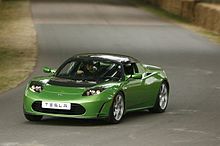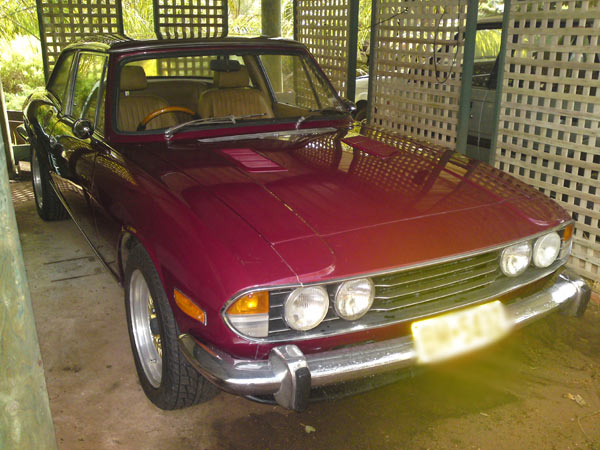
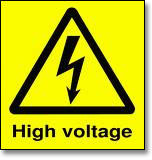
 Michael's big engineering project this year is the conversion of his 1976 Triumph Stag to an electric vehicle to be used as his daily drive. The technology now is such that it is a very viable proposition. We anticipate about a 150km range per charge with a top speed of about 130km/hr. Even charging on dirty power from coal fired power stations the CO2 emissions will be well less than 10% of a petrol vehicle and the batteries used will not be the rare earth ones used in Hybrid vehicles which put more CO2 into the atmosphere being made than you save in the life of the vehicle. We will be using the latest Li-Ion batteries.
Michael's big engineering project this year is the conversion of his 1976 Triumph Stag to an electric vehicle to be used as his daily drive. The technology now is such that it is a very viable proposition. We anticipate about a 150km range per charge with a top speed of about 130km/hr. Even charging on dirty power from coal fired power stations the CO2 emissions will be well less than 10% of a petrol vehicle and the batteries used will not be the rare earth ones used in Hybrid vehicles which put more CO2 into the atmosphere being made than you save in the life of the vehicle. We will be using the latest Li-Ion batteries.
Recharging will take about two hours using a small portable recharging unit costing with each charge costing about $7.90AUD. This is the equivalent of filling the tank on this car for about $25. The energy consumption of the car conservatively should be between 17-20kw/h per 100kms. At the time of writing we are paying 22c per kw/hr which equates to about $4.07/100kms which is about 20% of a petrol driven vehicle of similar size and power. The batteries should have a life of about 150000km and amortising their replacement costs over the life of the batteries adds about another 8c to the cost per km.. This conservatively places the running costs at 12c/km as opposed to the current running cost for that vehicle of 41c/km. These are conservative figures and we hope to significantly better these... fingers crossed.
We hope the keep the conversion costs below $25000AUD. The saving in running costs should pay for the conversion in about 85000km. We are fitting the car with reverse cycle air conditioning and retaining the power steering and power brakes utilising small efficient electric motor.
We hope to have this exciting fun project completed by the middle of 2012.

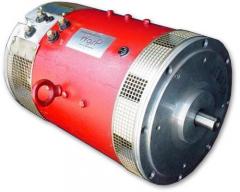
Tim Brunner from evworks.com.au in Perth is helping us with the vehicle conversion. Tim and EV Works is proud to have been awarded the contract to undertake the conversion of vehicles for the Western Australia Electric Vehicle Trial, the first of its kind in Australia. The trial will operate over 2012 - 2013, placing electric vehicles into the fleets of ten local businesses and government departments in order to evaluate their performance and feasibility. Click here to visit the media release at CO2Smart, the official trial manager.
If you want to learn more about converting your vehicle to electric then check out the evworks.com.au Introduction to Electric Vehicles page here.
I will be posting details of the projects process here as we go.
A little history
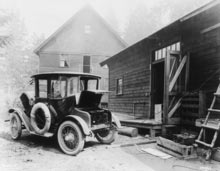 Electric cars are the future of transport so far as I can see. Electric cars greatly outnumbered petrol cars in the early 1900's. They enjoyed popularity between the mid-19th century and early 20th century, when electricity was among the preferred methods for automobile propulsion, providing a level of comfort and ease of operation that could not be achieved by the petrol cars of the time. Advances in internal combustion technology, especially the electric starter, soon rendered this advantage moot; the greater range of petrol cars, quicker refueling times, and growing petroleum infrastructure, along with the mass production of petrol vehicles by companies such as the Ford Motor Company, which reduced prices of petrol cars to less than half that of equivalent electric cars, led to a decline in the use of electric propulsion, effectively removing it from important markets such as the United States by the 1930s. However, in recent years, increased concerns over the environmental impact of petrol cars, higher fuel prices, improvements in battery technology, and the prospect of peak oil, have brought about renewed interest in electric cars, which are perceived to be more environmentally friendly and cheaper to maintain and run, despite high initial costs. Electric cars currently enjoy relative popularity in countries around the world, though they were absent from the roads of the United States, after they briefly re-appeared in the late 90s.
Electric cars are the future of transport so far as I can see. Electric cars greatly outnumbered petrol cars in the early 1900's. They enjoyed popularity between the mid-19th century and early 20th century, when electricity was among the preferred methods for automobile propulsion, providing a level of comfort and ease of operation that could not be achieved by the petrol cars of the time. Advances in internal combustion technology, especially the electric starter, soon rendered this advantage moot; the greater range of petrol cars, quicker refueling times, and growing petroleum infrastructure, along with the mass production of petrol vehicles by companies such as the Ford Motor Company, which reduced prices of petrol cars to less than half that of equivalent electric cars, led to a decline in the use of electric propulsion, effectively removing it from important markets such as the United States by the 1930s. However, in recent years, increased concerns over the environmental impact of petrol cars, higher fuel prices, improvements in battery technology, and the prospect of peak oil, have brought about renewed interest in electric cars, which are perceived to be more environmentally friendly and cheaper to maintain and run, despite high initial costs. Electric cars currently enjoy relative popularity in countries around the world, though they were absent from the roads of the United States, after they briefly re-appeared in the late 90s.
1890s to 1900s: Early history
Before the pre-eminence of internal combustion engines, electric automobiles held many speed and distance records. Among the most notable of these records was the breaking of the 100 km/h (62 mph) speed barrier, by Camille Jenatzy on April 29, 1899 in his 'rocket-shaped' vehicle Jamais Contente, which reached a top speed of 105.88 km/h (65.79 mph). Before the 1920s, electric automobiles were competing with petroleum-fueled cars for urban use of a quality service car. Proposed as early as 1896 in order to overcome the lack of recharging infrastructure, an exchangeable battery service was first put into practice by Hartford Electric Light Company for electric trucks. The vehicle owner purchased the vehicle from General Electric Company (GVC) without a battery and the electricity was purchased from Hartford Electric through an exchangeable battery. The owner paid a variable per-mile charge and a monthly service fee to cover maintenance and storage of the truck. The service was provided between 1910 to 1924 and during that period covered more than 6 million miles. Beginning in 1917 a similar service was operated in Chicago for owners of Milburn Light Electric cars who also could buy the vehicle without the batteries
Proposed as early as 1896 in order to overcome the lack of recharging infrastructure, an exchangeable battery service was first put into practice by Hartford Electric Light Company for electric trucks. The vehicle owner purchased the vehicle from General Electric Company (GVC) without a battery and the electricity was purchased from Hartford Electric through an exchangeable battery. The owner paid a variable per-mile charge and a monthly service fee to cover maintenance and storage of the truck. The service was provided between 1910 to 1924 and during that period covered more than 6 million miles. Beginning in 1917 a similar service was operated in Chicago for owners of Milburn Light Electric cars who also could buy the vehicle without the batteries
In 1897, electric vehicles found their first commercial application in the U.S. as a fleet of electrical New York City taxis, built by the Electric Carriage and Wagon Company of Philadelphia. Electric cars were produced in the US by Anthony Electric, Baker, Columbia, Anderson, Edison, Fritchle, Studebaker, Riker, Milburn, and others during the early 20th century.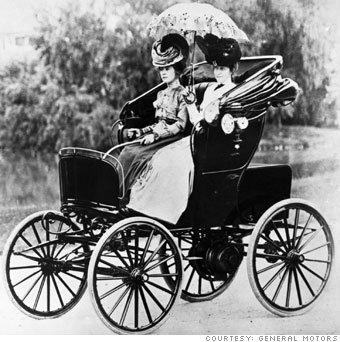 Despite their relatively slow speed, electric vehicles had a number of advantages over their early-1900s competitors. They did not have the vibration, smell, and noise associated with petrol driven cars. They did not require gear changes, which for petrol cars was the most difficult part of driving. Electric cars found popularity among well-heeled customers who used them as city cars, where their limited range was less of a disadvantage. The cars were also preferred because they did not require a manual effort to start, as did gasoline cars which featured a hand crank to start the engine. Electric cars were often marketed as suitable vehicles for women drivers due to this ease of operation.
Despite their relatively slow speed, electric vehicles had a number of advantages over their early-1900s competitors. They did not have the vibration, smell, and noise associated with petrol driven cars. They did not require gear changes, which for petrol cars was the most difficult part of driving. Electric cars found popularity among well-heeled customers who used them as city cars, where their limited range was less of a disadvantage. The cars were also preferred because they did not require a manual effort to start, as did gasoline cars which featured a hand crank to start the engine. Electric cars were often marketed as suitable vehicles for women drivers due to this ease of operation.
In 1911, the New York Times stated that the electric car has long been recognized as "ideal" because it was cleaner, quieter and much more economical than gasoline-powered cars.[22] Reporting this in 2010, the Washington Post commented that "the same unreliability of electric car batteries that flummoxed Thomas Edison persists today
Running costs and maintenance
The Tesla Roadster is sold in the US and Europe and has a range of 245 miles per charge.
Most of the running cost of an electric vehicle can be attributed to the maintenance and replacement of the battery pack because an electric vehicle has only around 5 moving parts in its motor, compared to a petrol driven car that has hundreds of parts in its internal combustion engine. Electric cars have expensive batteries that must be replaced but otherwise incur very low maintenance costs, particularly in the case of current Lithium based designs.
To calculate the cost per kilometer of an electric vehicle it is therefore necessary to assign a monetary value to the wear incurred on the battery. This can be difficult due to the fact that it will have a slightly lower capacity each time it is charged and is only considered to be at the end of its life when the owner decides its performance is no longer acceptable. Even then an 'end of life' battery is not completely worthless as it can be re-purposed, recycled or used as a spare.
Since a battery is made of many individual cells that do not necessarily wear evenly, periodically replacing the worst of them can retain the vehicle's range.
Range and refuelling time
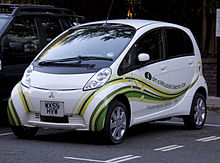 Cars with internal combustion engines can be considered to have indefinite range, as they can be refuelled very quickly almost anywhere. Electric cars often have less maximum range on one charge than cars powered by fossil fuels, and they can take considerable time to recharge. This is a reason that many automakers marketed EVs as "daily drivers" suitable for city trips and other short hauls. The average person drives less than 64 km per day; so the reality is that just about any electric car would suit most people as a daily drive and almost everyone as a second car. Nevertheless, opponents of this technology, mainly oil companies continue to cultivate anxiety through propaganda and mis-information. Many people can be concerned that they would run out of energy from their battery before reaching their destination, a worry so common now that it has its own name as a medical dis-order known as 'range anxiety'??????
Cars with internal combustion engines can be considered to have indefinite range, as they can be refuelled very quickly almost anywhere. Electric cars often have less maximum range on one charge than cars powered by fossil fuels, and they can take considerable time to recharge. This is a reason that many automakers marketed EVs as "daily drivers" suitable for city trips and other short hauls. The average person drives less than 64 km per day; so the reality is that just about any electric car would suit most people as a daily drive and almost everyone as a second car. Nevertheless, opponents of this technology, mainly oil companies continue to cultivate anxiety through propaganda and mis-information. Many people can be concerned that they would run out of energy from their battery before reaching their destination, a worry so common now that it has its own name as a medical dis-order known as 'range anxiety'??????
Energy efficiency
 Internal combustion engines are relatively inefficient at converting on-board fuel energy to propulsion as most of the energy is wasted as heat. On the other hand, electric motors are more efficient in converting stored energy into driving a vehicle, and electric drive vehicles do not consume energy while at rest or coasting, and some of the energy lost when braking is captured and reused through regenerative braking, which captures as much as one fifth of the energy normally lost during braking. Typically, conventional petrol engines effectively use only 15% of the fuel energy content to move the vehicle or to power accessories, and diesel engines can reach on-board efficiencies of 20%, while electric drive vehicles have on-board efficiency of around 80%+.
Internal combustion engines are relatively inefficient at converting on-board fuel energy to propulsion as most of the energy is wasted as heat. On the other hand, electric motors are more efficient in converting stored energy into driving a vehicle, and electric drive vehicles do not consume energy while at rest or coasting, and some of the energy lost when braking is captured and reused through regenerative braking, which captures as much as one fifth of the energy normally lost during braking. Typically, conventional petrol engines effectively use only 15% of the fuel energy content to move the vehicle or to power accessories, and diesel engines can reach on-board efficiencies of 20%, while electric drive vehicles have on-board efficiency of around 80%+.
Production and conversion electric cars typically use 10 to 23 kW·h/100 km (0.17 to 0.37 kW·h/mi). Approximately 20% of this power consumption is due to inefficiencies in charging the batteries. Tesla Motors indicates that the vehicle efficiency (including charging inefficiencies) of their lithium-ion battery powered vehicle is 12.7 kW·h/100 km (0.21 kW·h/mi) and the well-to-wheels efficiency (assuming the electricity is generated from natural gas) is 24.4 kW·h/100 km (0.39 kW·h/mi).
Click here to learn about our Cosmosis Personal Growth Mentoring
You can read about Michael's Mentoring Philosophy here
You can learn more about the Cosmosis process here
You can read Michael's articles here
Click here to learn more about how Cosmosis works
Want to get started or learn more? Click here
